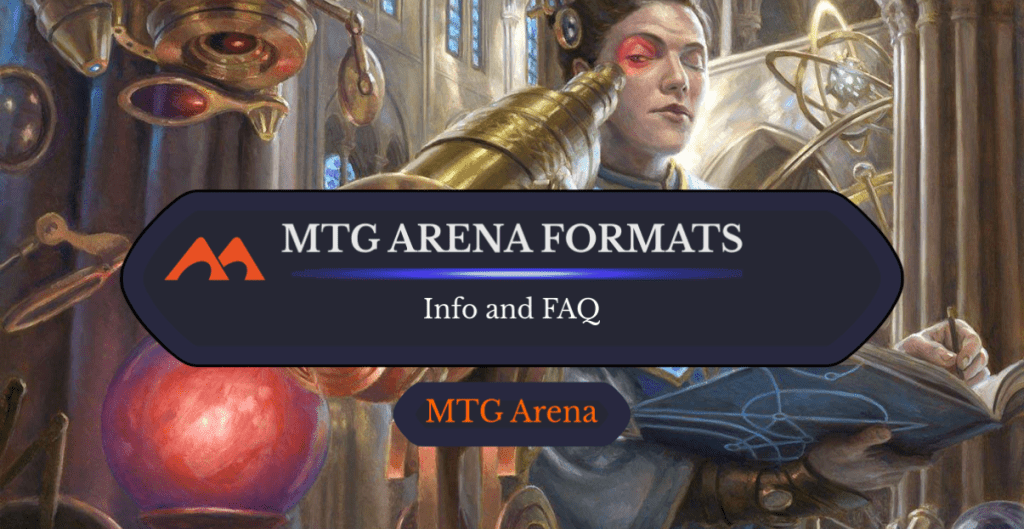
Divination | Illustration by Matt Stewart
MTG Arena has come a long way from the days when it first released, when Standard and Limited were pretty much your only options if you wanted to get a game in. We now have a lot of different formats, each with their own card pools, and it isn’t necessarily as simple as you might think to drop these formats into categories.
Today we’re going to take a look at as many different formats on Arena as we can. We’re looking at their card pools, popular decks, and who these formats appeal to. There’s a lot of these to look at, so let’s get started!
What Are Formats?
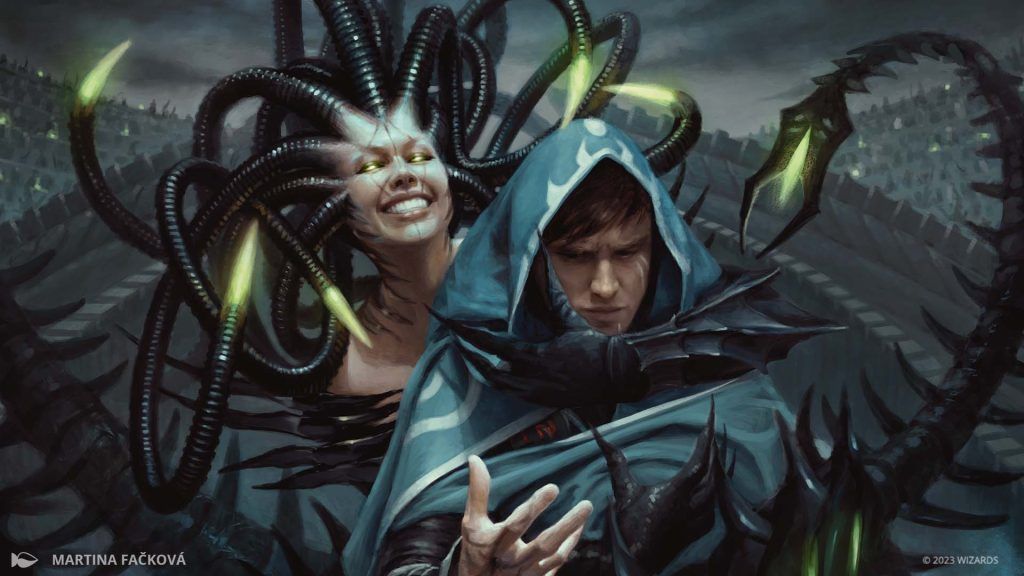
Phyrexian Arena | Illustration by Martina Fackova
Formats are what we call the different ways to play Magic. Unlike some TCGs out there, there are a LOT of ways to play Magic, and they all have their own card legalities, deck sizes, and sometimes special rules. Formats in Magic can be broken down into three basic categories:
- Constructed: For the longest time, this was the main way to play Magic. Constructed generally uses 60-card decks, with a 15-card sideboard if you’re playing best-of-three matches, and you’re not allowed to include more than four copies of a single card in your deck (except basic lands). Examples here include Standard and Modern.
- Limited: Unlike Constructed, in Limited you don’t need your own deck, but rather build it from a pool of cards supplied to you. Generally separated into either Draft or Sealed, you’ll usually build a 40-card deck from what you open/draft, and you’re allowed to add as many basic lands to that as you like.
- Highlander/Commander: This could be included with Constructed, but is probably useful to separate out. It’s often 100-card decks, potentially with some kind of General heading it up, and usually singleton, which is where the ‘Highlander’ bit comes from (there can be only one!). This is now easily the most played format in Magic, especially when looking at paper play.
All of these are relevant on Arena, although some more than others. Let’s take a look at the different formats on offer in detail.
Standard
Standard was the original 60-card format played on Arena and is still the most popular format on the client, at least in terms of games played. The card pool consists of the last two to three years’ Standard MTG sets, with the oldest four sets ‘rotating’ out each year with the release of the September Standard set. Until recently, Standard was made up of two years’ worth of sets (eight sets total), but the September 2023 rotation was cancelled, extending Standard to between 9-12 sets. At time of writing, Standard is made up of the sets from Innistrad: Midnight Hunt through Murders at Karlov Manor, with the oldest four sets (MID, VOW, NEO and SNC) due to rotate out with the release of Duskmourn: House of Horror in Q3 2024.
Standard has been around since pretty much the start of Magic, although it was originally called Type II. The rotation schedule is designed to keep the latest releases’ cards as the highlight of the format, although these releases can contain reprints from older sets, which would then be legal in Standard for as long as the set is in rotation.
Standard was the premier way to play competitive Magic for the longest time and was the focus of most tournaments, from casual FNMs to the Pro Tour and World Championships. In recent years it has seen a decline in popularity, due to external factors and changes to the competitive play scene. WotC seems to be putting more of a focus on Standard again, and is encouraging its play at both the LGS level and MagiCons.
Standard being made up of the most recent sets makes it easier to get into as a new player, particularly if you’re playing on Arena, as these are the sets that you’ll get the free prize packs from as you progress. Other formats can be more difficult to get into, as it can be challenging to source the cards from sets that were released a number of years ago, and you may therefore need more wildcards to craft the decks you want.
Due to the rotation of Standard, decks rise and fall in popularity all of the time. You can find out what’s popular right now on a variety of meta-breakdown pages online, including the Arena Tutor metadecks tab.
IMG: (any stock image of Arena Tutor’s metadeck’s tab)
Historic
Historic was the 2nd Constructed format to get its own queue on Arena. Brought in as a response to rotation as a way to keep playing your older cards that are no longer legal in Standard, Historic was intended as the place where you could build a deck with pretty much any card on Arena.
It’s changed quite a bit since it was originally introduced. Historic Anthologies, plus numerous bonus sheets, special sets like Lord of the Rings, as well as Alchemy cards have all pumped up the power of Historic, and changed the type of decks you see there. You get your typical Rakdos Midrange and mono red aggro decks that you seem to get in every format, but you also have decks like Primeval Titan Gates, or Izzet Wizards which are more unique to Historic.
Historic may have been superseded by Timeless recently, though, and although it still has its own queue, it feels like a lot of the hype has moved to the newer format, which pretty much has everything that Historic has, but more. Time will tell if Historic still has a place in the offerings on Arena.
Explorer
Explorer was introduced to combat problems that some players had around Alchemy and rebalanced cards entering Historic and changing the meta there. It’s intended as a format that can be played in paper, and as more cards are added it will eventually become Pioneer, with every tournament-relevant card that’s legal in Pioneer being on the Arena client. We’ll probably be at that point when and if Pioneer Horizons releases at the end of 2024.
The Explorer card pool consists of every card from Standard sets from Return to Ravnica, which was released in 2012, forward. The card pool continues to grow with every Standard set that comes out. At first we had Explorer Anthologies to bring key cards from pre-Arena sets into the Explorer card pool, but Pioneer Horizons should bring most of the rest to the client later this year.
Explorer has pretty much all of the coolest decks from Pioneer, with combo decks like Amalia Combo, slower decks with Azorius Control, and more. It even has all of the pieces for the latest hotness in Pioneer, Rakdos Vampires, which makes good use out of Vein Ripper and Sorin, Imperious Bloodlord.
With a format as wide open as Explorer is, I can’t recommend Arena Tutor higher, as it’ll help you track how well your deck performs against all of the other archetypes you’re facing along the way.
Timeless
Timeless is the newest format to come to Arena, and is also by far the most powerful format that you can play there. Essentially any card that’s on the client, including the Alchemy cards, is legal in the format, but some of the most powerful cards, such as Channel or Demonic Tutor, are restricted to one per deck, just like you tend to get in Vintage. There aren’t currently any banned cards in Timeless.
Timeless is where you get to play all of the broken combos you want. You still get mono red aggro stealing some wins, but you also have decks escalating the power of some of the most ridiculous Magic cards you can get in the format, like Show and Tell and Necropotence.
Timeless is still in its infancy and clearly has room to grow. With bonus sheets getting included in every set now we’ll likely see more broken cards from the history of paper play come to the client to be included here, keeping players on their toes.
Standard Brawl
Brawl (now named Standard Brawl on Arena) was the original Commander-like format that came to Arena, and still exists but doesn’t see as much play as Historic Brawl. Like Commander, Brawl uses a singleton deck with a “commander” that sets that deck’s color identity. Unlike Commander, the Brawl deck is 60 cards instead of 100, and can have a planeswalker leading it, instead of just a legendary creature. Also, it’s only 1v1 games as Arena doesn’t facilitate multiplayer games.
Brawl has the same card pool as Standard, which limits it quite a bit, but has its own benefits, including making decks easier to build for newbies. Most players prefer the deeper card pool of Historic Brawl, though.
Historic Brawl
Historic Brawl (now shortened to just Brawl on Arena) is the second incarnation of a Commander-like format on Arena, and brings it a good step closer to the paper version. It has a much bigger card pool, and also requires a 100-card deck, just like Commander. Historic Brawl does have Alchemy cards legal in it, however, which some players don’t like included.
Decks played here are many and varied, depending on each players’ preferences from the multitudes of legendary creatures available on the client. Some are more popular than others, of course, with some of the most played being the likes of Atraxa, Grand Unifier and Etali, Primal Conqueror.
The card pool is only going to grow as more cards are added to the client, whether through main sets, bonus sheets, Modern Horizons 3 or whatever. Pretty much any card printed in any of these places will find a home in some Brawl deck somewhere.
Limited
There are multiple Limited formats on Arena, but these all revolve around opening some cards and building a 40-card deck out of what you open. The two main types of Limited are Sealed, where you open six boosters and build from what you open, and Draft, where you only open three boosters, but “draft” them with seven other players. We have a guide for Draft if you’re unsure what this means.
In Limited, the decks on offer are different with every set, although some archetypes seem semi-evergreen, like Boros go-wide aggro, or Izzet spellslinger.
Draft is a fan favorite of both new and experienced players. It’s a good way to build a collection, whilst skill-testing and different every time you play. Of course, you can practice the draft portion here, in our namesake simulator! And use Arena Tutor to aid you if playing on Arena.
Jumpstart/Jump in
Jumpstart, sometimes called Jump In, is designed to be a “pick up and play” format where you can get a handful of new cards and jam a few games. These events are potentially aimed at newer players to introduce them to new cards while not really costing them much, but even some experienced players enjoy picking it up from time to time.
It works in a similar way to its paper counterpart. You’re given the choice of three themes for the first half of your deck, then you’re given some further choices for the second half. These get shuffled together into a 40-card Limited-like deck which you can play against other players. Themes you can pick up change regularly, but often you’ll get one based around a creature type like elves, a card type like enchantments or equipment, or even some themes that just mechanically go together like aggro!
Other Formats
The formats mentioned above are the main ones offered on Arena, with permanent queues offering play pretty much whenever you want. However, there are many other ways to play on Arena that pop up from time to time, such as in the Midweek Magic events.
Pauper is a Constructed format that only uses cards that have been printed at common. There’s a similar format that exists in paper play, and is a very popular competitive format in some parts of the world. Artisan is another spin on this, which allows you to also use uncommons. Remember, commons aren’t necessarily weak, and there are some powerful decks available even when you take rares and mythics out of the picture!
Momir is a novel format that’s often included in the Midweek Magic rotation. Instead of casting spells, your deck is made entirely of lands. Once per turn you can discard a land from your hand and pay an amount of mana. Arena will then randomly choose a creature with that mana value and put a token copy into play for you. Many players don’t enjoy the random nature of this, but it can be a fun, different way to play!
Sometimes you’ll see a format called On the Edge. This is usually a Standard format with the sets that are about to rotate removed from the card pool. It’s used as a preview for what Standard may look like after rotation happens.
Even with the above examples, there are still many strange formats occasionally offered up on Arena, with more being included all of the time in event/occasion formats. Keep your eyes out for any that might become available!
What Format is Best?
The argument of which format is best has been going on since Magic began, and there really isn’t any one right answer (although it’s definitely Draft!). However, Wizards has revealed some data on which are most played on Arena, which is quite interesting to look at.
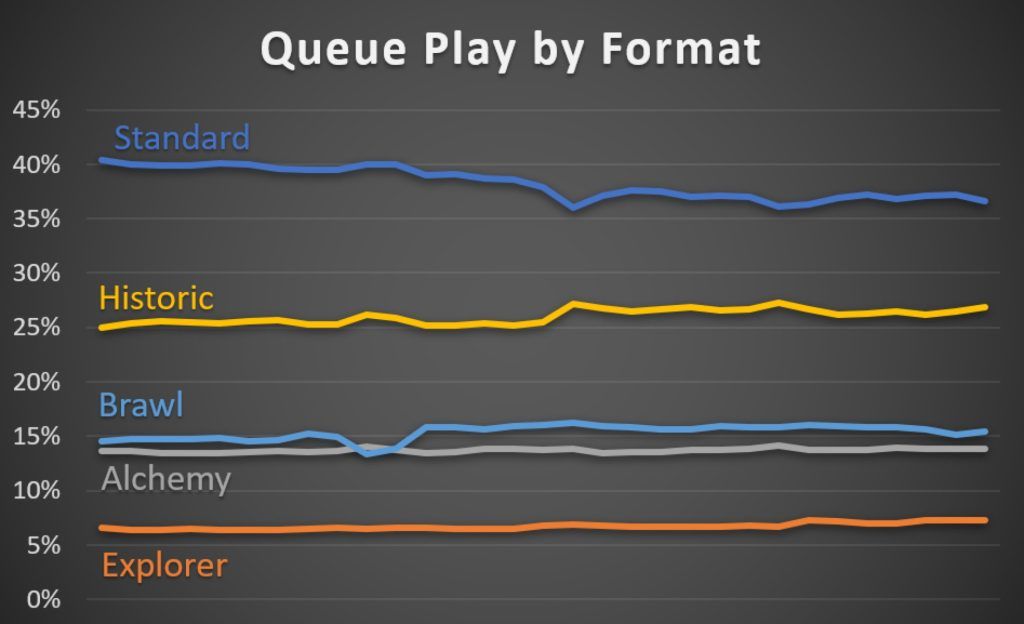
Standard is by far the most popular format, and has been for the whole time that the graph covers. This isn’t too surprising, as it’s the easiest format to get into, and the rewards on Arena are set up to encourage you to play Standard.
It’s interesting that Alchemy isn’t higher than shown. It’s a format that’s not generally popular with the vocal online fan base, but Arena defaults to offering Alchemy, so new players who aren’t part of the online masses may find themselves playing Alchemy automatically, without knowing any different.
Explorer is much less popular than I would have expected. The format is quite fun in my opinion, and you can keep a deck relevant for a long time. Not yet being equivalent to paper Pioneer may be a weakness for that format, and it’d be interesting to revisit this graph once the two formats are aligned.
Limited isn’t shown on here, but I (unfortunately) don’t expect it to come up very high on the list. It just isn’t as popular with the majority of players as Constructed formats are. Having to pay gems or gold to enter Draft or Sealed queues doesn’t help, of course!
Wrap Up

Arena Rector | Illustration by Ryan Pancoast
Arena has grown quite a bit since it first came out and only had Standard, plus a couple of Limited queues. It’s now got a format that’s quickly getting to the point where it fits between Modern and Legacy in terms of power level, but is still (relatively) friendly to newer players with Standard and Alchemy.
What’s your preference on Arena formats? Obviously Limited is top (not pushing my own view at all there), but what else takes your fancy? What would you like to see come to Arena, particularly if you assume that they can’t implement multiplayer on the client?
Let me know your thoughts in the comments below or in the Draftsim Discord server, and catch you in the next article!
Follow Draftsim for awesome articles and set updates: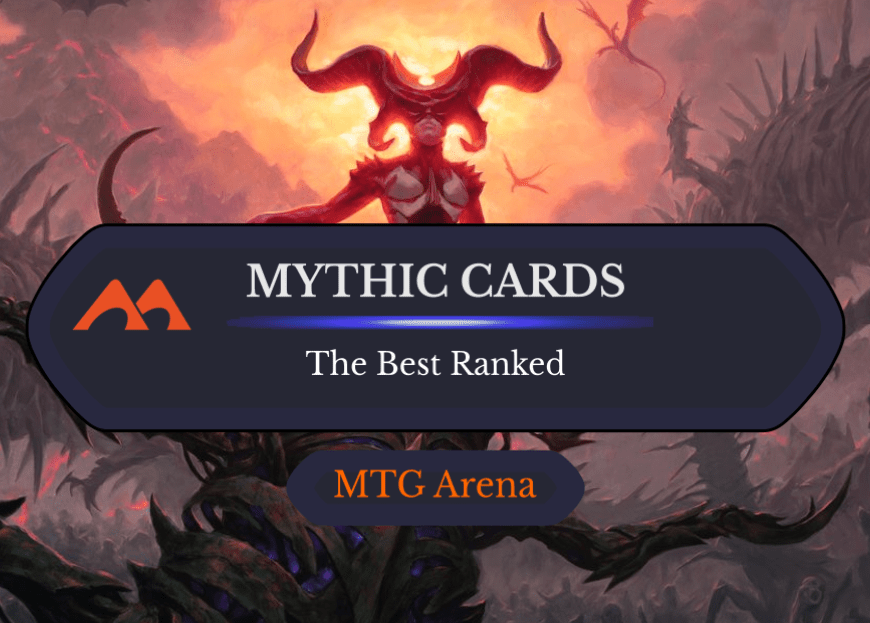
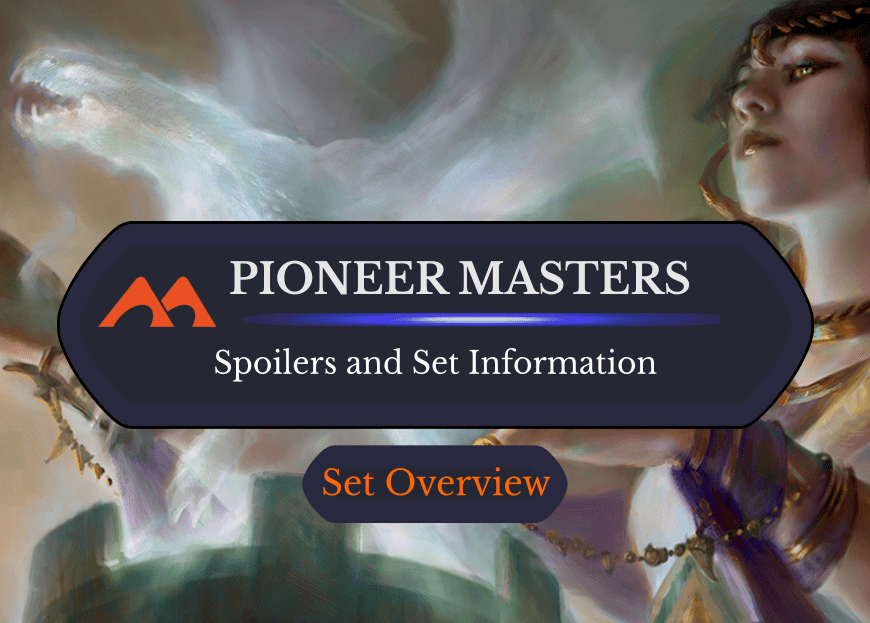
Add Comment